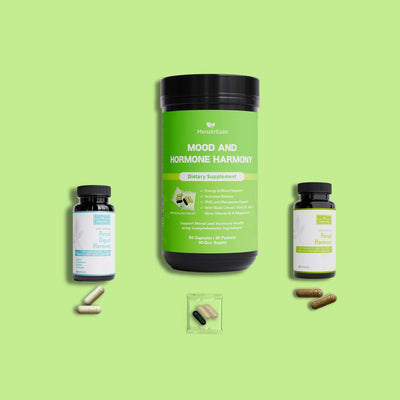Vitamin D, often referred to as the "sunshine vitamin," plays a crucial role in various bodily functions. It is primarily known for its role in calcium absorption and bone health. However, recent studies have suggested that it may also play a role in alleviating menstrual cramps, a common condition experienced by women of reproductive age. This article post aims to provide a comprehensive overview of the relationship between Vitamin D and menstrual cramps, exploring the scientific evidence behind this connection and discussing the potential benefits of Vitamin D supplementation for women suffering from menstrual pain.
The two main forms of vitamin D are: vitamin D3 (cholecalciferol) and vitamin D2 (ergocalciferol). Vitamin D3 is formed in the skin after exposure to sunlight or ultraviolet light; vitamin D2 is obtained by irradiation of plants or plant materials or foods. The vitamin D metabolites are bound in the circulation to vitamin D binding protein.
1. The Role of Vitamin D
Vitamin D is a fat-soluble vitamin that our bodies produce when exposed to sunlight. A fun fact about vitamin D is that it is believed to be one of the oldest hormones that have been made in the earliest life forms for over 750 million years. It is also recognized that a wide variety of tissues (including colon, prostate, breast, and skin) have vitamin D involved enzymatic machinery in the biological process.
Vitamin D promotes calcium absorption in the gut and maintains adequate serum calcium and phosphate concentrations to enable normal bone mineralization and to prevent involuntary contraction of muscles, which leads to cramps and spasms. It is also needed for bone growth and bone remodeling by osteoblasts and osteoclasts. Without sufficient vitamin D, bones can become thin, brittle, or misshapen. Vitamin D sufficiency prevents rickets in children and osteomalacia in adults. Together with calcium, vitamin D also helps protect older adults from osteoporosis.
Besides, vitamin D has other roles in the body, including reduction of inflammation as well as modulation of such processes as cell growth, neuromuscular and immune function, and glucose metabolism. Many genes encoding proteins that regulate cell proliferation, differentiation, and apoptosis are modulated in part by vitamin D. Many tissues have vitamin D receptors, and some convert 25(OH)D to 1,25(OH)2D.
Vitamin D can also be obtained from certain foods, such as fatty fish, cheese, and egg yolks, or through supplementation. Vitamin D is essential for the absorption of calcium, a mineral that is crucial for bone health. However, its role extends beyond bone health. Research has suggested that Vitamin D may play a role in immune function, mood regulation, and pain relief – there might be adverse impact of vitamin D insufficiency on skeletal, infectious/inflammatory, and metabolic health in humans.
2. Vitamin D and Menstrual Cramps: The Connection
Despite its established benefits, the role of Vitamin D in managing menstrual cramps is a relatively new area of research. Several studies have begun to shed light on this relationship. In fact, vitamin D is a steroid hormone that is mainly produced in the skin or through exposure to sunlight (80–90%), and the rest is provided through diet and supplementation. Studies showed that the decrease in serum 25-hydroxyvitamin D to less than 12 ng/ml is the sign of vitamin D deficiency.
Some studies indicated a beneficial impact of cholecalciferol on such menstrual dysfunctions as oligomenorrhea and dysmenorrhea. Regarding numerous information on the function of vitamin D, both traditional and lately published, there may be a sturdy correlation among vitamin D deficiency and menstrual dysfunction. Also, because the vitamin D receptor is widespread and the mitochondrial cytochrome P450 enzyme, which catalyzes the synthesis of D3 from its precursor 25(OH) D, is expressed in the human uterus and in immune system cells, and due to the fact vitamin D decreases the synthesis of PGs, a beneficial impact of vitamin D in the uterus pathophysiology is feasible.

3. Clinical Evidence
High-dose vitamin D supplementation significantly reduces the prevalence and symptoms of PMS and dysmenorrhea among adolescents, suggesting a potent strategy for managing these conditions.
Systematic reviews confirm that calcium and vitamin D play crucial roles in reducing PMS symptoms, recommending them as effective, low-risk treatments. Furthermore, vitamin D supplementation in adolescents with severe hypovitaminosis D has demonstrated substantial improvements in PMS-related mood disorders.
Additionally, vitamin D supplementation effectively reduces pain and systemic symptoms in women with primary dysmenorrhea and vitamin D deficiency, highlighting its potential as a non-pharmacological treatment option.
These findings underscore the importance of considering vitamin D and calcium supplementation as part of a comprehensive approach to managing PMS and dysmenorrhea.
- One study in 2009 aimed to evaluate and compare the efficacy of dydrogesterone and calcium plus vitamin D supplementation in alleviating severe premenstrual syndrome (PMS) symptoms. Conducted as a randomized, double-blind, placebo-controlled trial, it involved 180 Shiraz University students diagnosed with PMS. Participants documented their symptoms over two menstrual cycles, then were randomly assigned to receive either 5 mg dydrogesterone, 500 mg calcium plus 200 IU vitamin D, or a placebo, taken twice daily from the 15th to the 24th day of their menstrual cycle for two additional cycles. Symptom severity was assessed using questionnaires during the intervention. The results indicated that both dydrogesterone and calcium plus vitamin D supplementation similarly reduced PMS symptom severity (by 4.64% and 4.20% respectively), compared to a 3.42% decrease observed with placebo treatment. The conclusion drawn from these findings is that dydrogesterone and calcium plus vitamin D offer comparable benefits in reducing PMS symptoms, suggesting either treatment could be considered as an option for managing severe PMS.
- Another study in 2018 evaluated the effects of high-dose vitamin D supplementation on dysmenorrhea and premenstrual syndrome (PMS) in 897 adolescent girls in Mashhad and Sabzevar, Iran. Participants received nine weekly doses of 50,000 IU of cholecalciferol (vitamin D3) over 9 weeks. The study categorized participants into four groups: those with only PMS, those with only dysmenorrhea, those with both conditions, and normal subjects without these conditions. The findings revealed a significant reduction in PMS prevalence, from 14.9% to 4.8% (p < .001), after vitamin D supplementation. The prevalence of dysmenorrhea also decreased slightly from 35.9% to 32.4%, and the incidence among subjects with both PMS and dysmenorrhea reduced from 32.7% to 25.7%. Moreover, the supplementation led to a decrease in several PMS symptoms, such as backache and a tendency to cry easily, and a reduction in the pain severity of dysmenorrhea (p < .05). The study concluded that high-dose vitamin D supplementation could effectively reduce the prevalence of PMS and dysmenorrhea, alongside improving both physical and psychological symptoms associated with PMS.
- A systematic review in 2019 assessed the impact of calcium and vitamin D on premenstrual syndrome (PMS) by analyzing 28 high-quality articles from various databases. It found that low serum levels of these nutrients during the luteal phase may contribute to PMS symptoms. Supplementation or dietary intake of calcium and vitamin D was recommended as an effective, low-risk, and cost-efficient approach to alleviate PMS symptoms, highlighting their significance in managing this common disorder among women of reproductive age.
- A new study in 2016 aimed to evaluate the effectiveness of vitamin D supplementation in young girls (15-21 years old) with severe hypovitaminosis D and premenstrual syndrome (PMS), particularly focusing on mood disorders. A total of 158 participants with severe PMS symptoms and low serum levels of 25-hydroxycholecalciferol (≤10 ng/mL) were randomly assigned to receive either vitamin D (200,000 IU initially, followed by 25,000 IU biweekly for 4 months; group 1, n=80) or a placebo (group 2, n=78). The study assessed the clinical and hormonal effects of the treatment. Results showed that in the vitamin D group, serum levels reached the normal range (35-60 ng/mL) within the first month and remained stable. Significant improvements were observed in anxiety, irritability, ease of crying, sadness, and disturbed relationships scores, with no significant changes in the placebo group. The frequency of adverse events, including nausea and constipation, was similar between the two groups. The conclusion drawn from the study is that vitamin D supplementation is a safe, effective, and convenient treatment for improving the quality of life in young women with severe hypovitaminosis D and mood disorders associated with PMS.
- Another new study in 2021 aimed to assess the impact of vitamin D supplementation on pain and systemic symptoms in female students aged 18 to 32 years with primary dysmenorrhea and vitamin D deficiency. In this double-blind, randomized, placebo-controlled trial, 116 participants were divided into two groups, receiving either 50,000 IU of vitamin D3 (cholecalciferol) or a placebo weekly for eight weeks. The evaluation focused on pain intensity, days with pain, consumption of pain-relief medications, and severity of systemic symptoms such as fatigue, headache, nausea/vomiting, and diarrhea. The results demonstrated that participants who received vitamin D supplements showed significant improvements in all measured outcomes. There was a notable decrease in pain intensity, fewer days with pain, reduced consumption of pain-relief medications, and a decrease in the severity of systemic symptoms at both the 4-week and 8-week marks, with all changes being statistically significant (P<0.001). No significant improvements were observed in the placebo group. The conclusion drawn from the study is that vitamin D supplementation can effectively reduce pain intensity, decrease the number of days with pain, lessen the need for pain-relief medications, and improve systemic symptoms in women with primary dysmenorrhea and vitamin D deficiency.
4. Intake Source of Vitamin D
You can take vitamin D either from food, sun exposure or dietary supplements:
4.1 Food
Few foods naturally contain vitamin D. The flesh of fatty fish (such as trout, salmon, tuna, and mackerel) and fish liver oils are among the best sources. An animal’s diet affects the amount of vitamin D in its tissues. Beef liver, egg yolks, and cheese have small amounts of vitamin D, primarily in the form of vitamin D3 and its metabolite 25(OH)D3. Mushrooms provide variable amounts of vitamin D2. Some mushrooms available on the market have been treated with UV light to increase their levels of vitamin D2. In addition, the Food and Drug Administration (FDA) has approved UV-treated mushroom powder as a food additive for use as a source of vitamin D2 in food products.
4.2 Sun Exposure
Most people in the world meet at least some of their vitamin D needs through exposure to sunlight. Type B UV (UVB) radiation with a wavelength of approximately 290-320 nanometers penetrates uncovered skin and converts cutaneous 7-dehydrocholesterol to pre-vitamin D3, which in turn becomes vitamin D3. Some expert bodies and vitamin D researchers suggest, for example, that approximately 5–30 minutes of sun exposure, particularly between 10 a.m. and 4 p.m., either daily or at least twice a week to the face, arms, hands, and legs without sunscreen usually leads to sufficient vitamin D synthesis. But despite the importance of the sun for vitamin D synthesis, limiting skin exposure to sunlight and UV radiation from tanning beds is prudent. UV radiation is a carcinogen, and UV exposure is the most preventable cause of skin cancer. Therefore, in practice, it is highly recommended to apply enough sunscreen.
4.3 Dietary supplements
Dietary supplements can contain vitamins D2 or D3. Vitamin D2 is manufactured using UV irradiation of ergosterol in yeast, and vitamin D3 is typically produced with irradiation of 7-dehydrocholesterol from lanolin obtained from the wool of sheep. An animal-free version of vitamin D3 sourced from lichen is also available. People who avoid all animal-sourced products can contact dietary supplement manufacturers to ask about their sourcing and processing techniques.

4.4 The Benefits of Vitamin D Supplementation
Given the potential role of Vitamin D in alleviating menstrual cramps, Vitamin D supplementation may be beneficial for women suffering from this condition. However, it is important to note that the optimal dosage and duration of Vitamin D supplementation for menstrual cramps have not been established. However, it has been suggested that the Recommended Dietary Allowances (RDAs) for Vitamin D is 15 mcg (600 IU) for female between 1-70 year(s) old. Generally, women considering Vitamin D supplementation should consult with a healthcare provider to determine the appropriate dosage and duration of supplementation.
In addition to potentially alleviating menstrual cramps, Vitamin D supplementation may offer other health benefits, including improved bone health, enhanced immune function, and improved mood. Therefore, Vitamin D supplementation may not only help to alleviate menstrual cramps but also contribute to overall health and well-being.
5. Conclusion
While more research is needed to fully understand the relationship between Vitamin D and menstrual cramps, current evidence suggests that vitamin D supplementation may be a promising approach for women suffering from this condition. However, it is important for you to consult with a healthcare provider before starting any new supplementation regimen. As research continues to uncover the many roles of Vitamin D in the body, it is becoming increasingly clear that this "sunshine vitamin" has much more to offer than just improving bone health.






